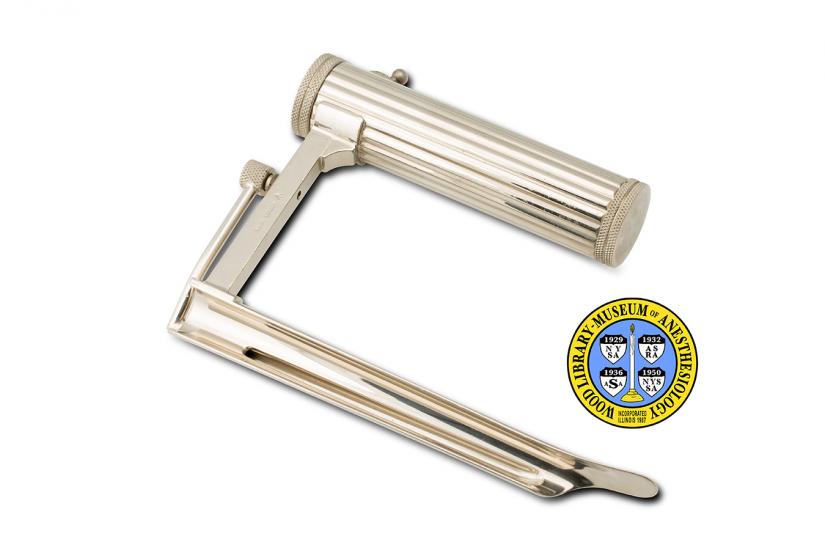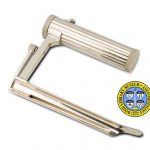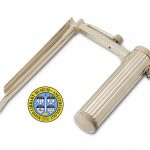Magill Laryngoscope
General anesthesia can decrease the patient’s ability to breathe normally. To maintain an open airway, anesthesiologists may insert a plastic tube into the patient’s trachea (wind pipe.) One of the tools for this purpose is a laryngoscope, used to view the larynx (voice box), which is the opening to the trachea and lungs. The laryngoscope “blade” is shaped to act as a tongue depressor and viewing channel for placing the tube.
British anesthesiologists Sir Ivan W. Magill (1888-1986) and Dr. Stanley Rowbotham (1890-1979) worked at Queen’s Hospital for Facial and Jaw Injuries following WWI. Together they developed new methods needed for these difficult cases of plastic surgery. Among the pieces of equipment they designed was this laryngoscope, introduced in 1926, as well as forceps and tubes for nasal intubation. All three of these inventions are still in use today. Both men went on to become leaders of the specialty. Dr. Magill is credited with bringing the technique of endotracheal anesthesia to its current prominence. His accomplishments won him many honors. In 1946, he was knighted for his services to the Royal Family. This example of the Magill laryngoscope was made by the English firm, John Weiss & Sons.
Catalog Record: Magill Laryngoscope
Access Key: aleq
Accession No.: 2001-11-05-1
Title: [Magill laryngoscope.]
Author: Magill, Ivan W. (Whiteside), 1888-1986.
Publisher: London : Weiss, [between 1926 and 1950?].
Physical Descript: 1 laryngoscope : metals ; 14.5 x 3.5 x 19.5 cm.
Subject: Laryngoscopes – straight blades.
Subject: Laryngoscopy.
Subject: Airway Management – instrumentation.
Subject: Airway Management Equipment.
Subject: Intubation, Intratracheal – instrumentation.
Subject: Magill, Ivan Whiteside, Sir, 1888-1986.
Note Type: General
Notes: The early year in the date range for the possibly ear of manufacture is based
on the year that Dr. Magill published an article about the laryngoscope
(Magill, 1926). The end date is an estimate based on the introduction of
laryngoscopes with detachable blades during the 1940s. The date range could
change if documentation, or expert opinion, indicates that it should be
corrected.
Note Type: Citation
Notes: Magill IW. An improved laryngoscope for anaesthetists. Lancet.
1926;207(5349:500.
Note Type: Citation
Notes: Magill IW. The provision for expiration in endotracheal insufflation
anaesthesia. Lancet. 1923;202(5211):68-69.
Note Type: Citation
Notes: McLachlan G. Sir Ivan Magill KCVO, DSc, MB, BCh, BAO, FRCS, FFARCS (Hon),
FFARCSI (Hon), DA, (1888-1986). Ulster Med J. 2008;77(3):146–152. https://www.
ncbi.nlm.nih.gov/pmc/articles/PMC2604469/. Accessed January 30, 2015.
Note Type: Citation
Notes: Shilling AM, Durbin CG Jr. Airway management devices and advanced cardiac
life support. In: Cairo JM, ed. Mosby’s Respiratory Care Equipment. St. Louis
Missouri: Elsevier Mosby; 2014:131. [“The modern laryngoscope was not
invented until the 1940s and consisted of a handle containing a battery and
detachable blade with a light bulb.”]
Note Type: Citation
Notes: Thomas KB. Sir Ivan Whiteside Magill, KCVO, DSc, MB, BCh, BAO, FRCS, FFARCS
(Hon), FFARCSI (Hon), DA: a review of his publications and other references
to his life and work. Anaesthesia. 1978;33(7):628-634.
Note Type: Physical Description
Notes: One U-shaped laryngoscope with a straight blade; The measurements and
physical description are patient based, as though the laryngoscope is about
the be inserted; The blade has a slight curve at the proximal end; The flange
has a “C” shaped cross section; Space for a light is located on the distal
end of the blade; There is no bulb in the space; The blade alone measures
approximately 18 cm in length; The bar connecting the blade and the handle is
approximately 8 cm in length; There is an on/off switch on the handle; The
handle is fluted and measures approximately 13.3 cm in length and 3.2 cm in
diameter; The only markings are on the bar connecting the blade and handle
and are, “WEISS LONDON”.
Note Type: Reproduction
Notes: Photographed by Mr. Steve Donisch, February 11, 2014.
Note Type: Historical
Notes: Dr. Ivan Whiteside Magill (1888-1986) was a British anaesthetist who
introduced a number of advancements in anesthesia equipment and techniques.
In 1926, when Dr. Magill introduced the “improved laryngoscope for
anaesthetists,” he had been administering intratracheal insufflation
anesthesia for about six years. Intratracheal insufflation involved passing a
tube, or tubes, through the mouth or nose into the trachea (the main windpipe
of the lungs) so that anesthetic gas mixtures and air could be continuously
blown through the tube and into the patient’s lungs by a motorized pump. In
1922, Magill began to use a second tube to provide a secure pathway for
expired gases.
Magill used a laryngoscope to gently lift the tongue and tissue in the throat
just enough to see the opening to the lungs (larynx). This allowed him to
safely insert the insufflation tube. In his 1926 article, Magill highlighted
a few features of his stainless steel laryngoscope that made it especially
useful for anesthesiologists administering intratracheal insufflation. It
provided good illumination via a small ‘lens-fronted’ electric light bulb.
The end of the blade (the part that enters the mouth) was relatively flat and
wide and tilted slightly upward. He believed that this allowed the
anaesthetist to better elevate and control the tissue that normally covers
the larynx (the epiglottis). Additionally he believed that the
cross-sectional shape of the blade (a wide open ‘C’) optimized the view of
the larynx and provided space for tubes and forceps.
The original design had a protrusion in the handle that provided purchase for
the thumb. Magill believed this gave the anaesthetist better control when
maneuvering the laryngoscope into position. The laryngoscope described here
lacks the thumb hold, and the part of the handle that runs parallel to the
blade is shaped to hold batteries, whereas the original was not.
Some of the other pieces of anesthesia equipment Dr. Magill designed include
the Magill Forceps, the Magill Endotracheal Tube, and more than one portable
apparatus for insufflation anesthesia.
For more biographical information on Sir Ivan Magill, see the catalog record
and website caption for the Magill Forceps (WLM ID: akxd;
https://woodlibrarymuseum.org/museum/item/777/magill-forceps), and the catalog
records and website captions for the Magill Tubes (WLM ID: akvu, akvv, akvw,
akvx, akvy; https://woodlibrarymuseum.org/museum/item/778/magill-nasal-tubes).
Note Type: Publication
Notes: Kilner TP. Ivan Whiteside Magill, C.V.O., D.Sc., F.R.C.S., honorary member,
British Association of Plastic Surgeons. Br JPlastic Surg. 1953;6(3):150-152.
Note Type: Exhibition
Notes: Selected for the WLM website.



